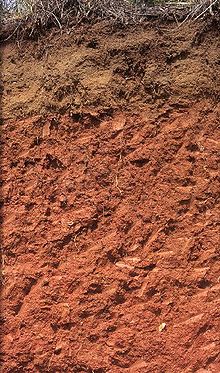Ultisol
As Ultisol one of the designated according to USDA Soil Taxonomy soil of the tropics and subtropics , due to intense weathering and leaching moderately to highly acidic are. They are found particularly in the southeastern parts of the USA , in Central America , Brazil and Argentina , West and Central Africa , Southeast Asia and parts of Korea , Japan and northeastern Australia and have mostly developed over a relatively long period of time.
A moderately humus A-horizon, followed by a pale, often yellowish-colored eluvial horizon is typical for Ultisole. Below that lies a more clay-rich B horizon, often colored red by iron oxides .
In terms of arable farming, Ultisols can only be used after intensive fertilization, as most of the nutrients have been transferred to deeper soil horizons or washed out by weathering. The low pH value also has to be raised by adding lime. From a forestry point of view, on the other hand, ultisols are considered to be very productive.
In the World Reference Base for Soil Resources (WRB) they correspond to the alisols and acrisols .
Worldwide about 11 million square kilometers of land are covered by Ultisolen, which corresponds to 8.5 percent of the ice-free land area.
classification
Ultisole is divided into five sub-orders:
Web links
- Ultisols (PDF, 906 kB)
literature
- Soil Survey Staff: Soil Taxonomy: A Basic System of Soil Classification for Making and Interpreting Soil Surveys. 2nd edition. Natural Resources Conservation Service. US Department of Agriculture Handbook 436.Washington DC, USA, 1999.
- Soil Survey Staff: Keys to Soil Taxonomy. 12th edition. Natural Resources Conservation Service. US Department of Agriculture. Washington DC, USA, 2014.
